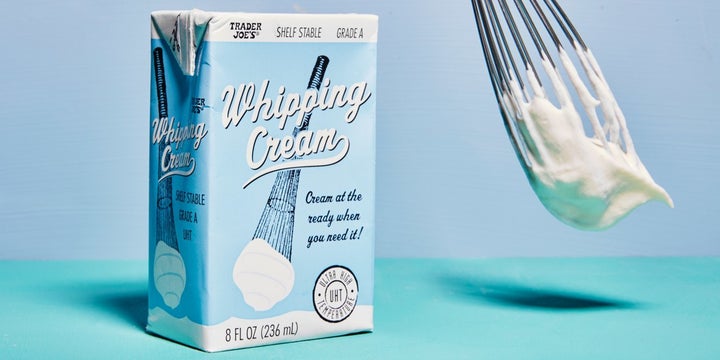For Epicurious, by Anya Hoffman.

As with every other dairy product, I don’t buy whipping cream unless I know I’m going to use it, lest it languish in the fridge and go bad before I have a chance to cook with it. But because I don’t buy it regularly, I never seem to have it on hand in those moments when I really want and need it. Like, say, when I want to add a splash of cream to braised chicken or whip some up for a peach parfait. (Or, you know, when I get the urge to make homemade coffee butter. Which, it turns out, is super easy...when you have heavy cream in the house.)
Yes, in my house, every cream usage is a pre-planned event. But I recently saw a product on the shelves (shelves! This part is important!) at Trader Joe’s that promised to solve this cream-free negative feedback loop. It was right there, in the canned goods aisle, not far from the jars of olives and mysterious tubes of “umami stir-in paste”: little eight-ounce boxes of shelf-stable whipping cream.
WHAT IS SHELF-STABLE WHIPPING CREAM?
Similar to the shelf-stable milk cartons popular in Europe, this whipping cream has undergone Ultra-High Temperature (UHT) pasteurization, during which the cream is heated to 280 degrees Fahrenheit for two to four seconds, a process that kills all the bacteria in it. Without that pesky bacteria, the cream can last for up to six months in an unopened container, no refrigeration necessary.
HOW DOES IT TASTE?
When sipped on its own, the TJ’s shelf-stable whipping cream tastes slightly blander and less creamy than its regular, non-ultra-pasteurized, found-in-the-refrigerated-dairy-aisle whipping cream counterparts. But since we don’t tend to pour ourselves glass of whipping cream for sipping, this seems like a minor drawback. When stirred into a dish, it’s hard to taste the difference. (Note: This product does contain carrageenan, a seaweed-derived food additive commonly used as a thickener and stabilizer in dairy products and nut and soy milks, which some people like to avoid because of concerns about possible, although as of yet not conclusively proven, health risks.)
Get this recipe: Pumpkin Pie-Spice Whipped Cream
HOW DOES IT WHIP?
Herein lies the major drawback of the impromptu cream usage: the shelf-stable stuff has to be refrigerated for at least six hours before being whipped. Of course, this isn’t much of a surprise: cream always whips better when it’s cold (in fact, I try to stick the bowl and whisk I’m going to use to make whipped cream in the freezer for a few minutes before using them).
Still, having to remember to stick the box of cream in the fridge the morning before a dinner party seems easier than having to remember to buy the cream in the first place. Plus, now that I can stock my pantry with boxes of cream from my favorite supermarket, my salad dressings, soups, French toast, and pastas need never go without cream again.
Get this recipe: Little Gem Salad with Lemon Cream and Hazelnuts
More from Epicurious:
